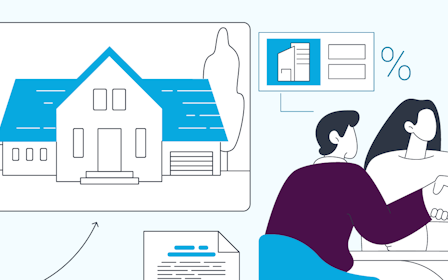When you’re exploring ways to finance a home, you’ll likely come across the term adjustable-rate mortgage—often shortened to ARM. But what exactly does it mean, and why might some buyers choose an ARM instead of a fixed-rate mortgage? Let’s break it down.
What Is an Adjustable-Rate Mortgage?
An adjustable-rate mortgage (ARM) is a type of home loan where the interest rate changes over time instead of staying fixed for the entire term.
- Initial Phase: The loan begins with a fixed-rate period—commonly 5, 7, or 10 years—where your monthly payment remains steady.
- Adjustment Phase: After that period, the interest rate adjusts at set intervals (often once a year), moving up or down based on broader market conditions.
This structure makes ARMs appealing to some buyers, especially those who don’t plan to stay in their home long-term.
Adjustable-Rate Mortgages in Today’s Market
Adjustable-rate mortgages tend to draw more attention when interest rates are higher or fluctuating. For buyers in markets like California or Colorado—where home prices can stretch affordability—ARMs often serve as a way to secure lower initial monthly payments compared to fixed-rate options. Even with the possibility of subsequent adjustments, many buyers see the upfront savings as an opportunity to enter the housing market sooner.
In fact, lenders like our affiliate Inspire Home Loans® can help you evaluate whether an ARM offers a competitive edge compared to a 30-year fixed loan. Considering not just current rates, but also long-term financial goals and housing plans, can help you better determine if an ARM fits your unique situation.
How ARMs Work
You’ll often see ARMs described in terms like “5/6 ARM.” Here’s what that means:
- “5” = Fixed Period: For the first five years, your rate stays the same
- “6” = Adjustment Frequency: After that, your rate adjusts every six months.
To protect homeowners, most ARMs come with rate caps—limits on how much your rate can rise at each adjustment and over the life of the loan. These caps limit the amount a monthly payment can increase.
ARM vs. Fixed-Rate Mortgage: A Quick Comparison
Adjustable-Rate Mortgage
- Initial Interest Rate: Usually lower than fixed-rate loans
- Monthly Payments: Stable during fixed period, then increase
- Flexibility: Good if you plan to move, refinance, or upgrade within the fixed period
- Risk Level: Higher than fixed rate; payments may increase after fixed period
Fixed-Rate Mortgage
- Initial Interest Rate: Typically higher at the start
- Monthly Payments: Consistent for the entire loan term
- Flexibility: Best if you plan to stay long-term
- Risk Level: Low—payments won't change
Example: How an ARM Might Work
Jordan and Taylor are first-time buyers. They know they’ll relocate for work within five years. Instead of choosing a 30-year fixed-rate loan, they opt for a 5/6 ARM.
- Their monthly payments are lower during the initial five years.
- Because they plan to sell before the adjustment kicks in, they won’t face any rate changes.
For their situation, the ARM may make financial sense.
Benefits of an Adjustable-Rate Mortgage
- Lower Initial Payments: Many ARMs begin with a rate that’s lower than a comparable fixed-rate mortgage, easing monthly costs during the early years.
- Flexibility for Short-Term Buyers: If you move, sell, or refinance before the adjustment period, you may never face a higher payment.
Example: A first-time buyer planning to upgrade within five years could save thousands in upfront interest, making it easier to build equity or set aside cash for future expenses.
Risks of an Adjustable-Rate Mortgage
- Uncertainty After the Fixed Period: Payments may rise sharply if interest rates increase.
- Market Dependency: Fluctuating payments make long-term financial planning more complex.
- Budgeting Challenges: Your mortgage is tied to national and global economic shifts you can’t control.
Example: A buyer purchasing their “forever home” might find the unpredictability of an ARM stressful, since they plan to stay long past the fixed-rate period.
Who Typically Chooses an ARM?
ARMs aren’t just for one type of buyer. They tend to work well for:
- First-time homebuyers who need a lower entry point into competitive housing markets.
- Relocating professionals who anticipate job transfers within five to seven years.
- Investors or second-home buyers who may sell the property in a shorter timeframe.
By aligning the loan structure with expected timelines, these buyers balance affordability with future flexibility.
Is an ARM Right for You?
An ARM can be a smart choice if:
- You expect to relocate, upgrade, or refinance within a few years.
- You want to lower your monthly mortgage payment early on.
- You’re comfortable with possible future payment increases.
On the other hand, if you value stability and predictable payments, a fixed-rate mortgage may be the better fit.
Tip: It’s best to consult with a loan specialist—such as our in-house lender Inspire Home Loans®—to evaluate your comfort level and long-term financial goals.
The Bottom Line on ARMs
An adjustable-rate mortgage offers flexibility and lower initial payments, making it a good option for certain buyers. By understanding how ARMs work—and how they compare to fixed-rate loans—you’ll be better prepared to choose the financing that supports your long-term goals.
Looking for more financing resources? Talk with our affiliate lender Inspire Home Loans® or read more about other types of home loans to keep your homebuying journey moving forward.
Ready to start shopping for your dream home? Contact one of our local sales teams today or explore our website for available homes near you.
FAQs About Adjustable-Rate Mortgages
Is an adjustable-rate mortgage a good idea?
It depends on your situation. ARMs work well for buyers who move, refinance, or upgrade before the adjustment phase begins.
How often does an ARM adjust?
Most ARMs adjust once per year after the fixed period, though some (like the 5/6 ARM) adjust every six months.
What is the biggest risk of an ARM loan?
The biggest risk is uncertainty—your payments could increase if market rates rise.
What is the difference between a 5/1 ARM and a 5/6 ARM?
Both have a five-year fixed-rate period, but the adjustment frequency differs. A 5/1 ARM adjusts annually after five years, while a 5/6 ARM adjusts every six months.
Can I refinance an ARM into a fixed-rate mortgage later?
Yes. Many homeowners refinance into a fixed-rate loan before the adjustment period begins, especially if market rates are rising.
Do government-backed loans allow ARMs?
Yes, ARMs are available for certain FHA and VA loans. These programs come with specific rules and protections, making them worth exploring with your lender.






